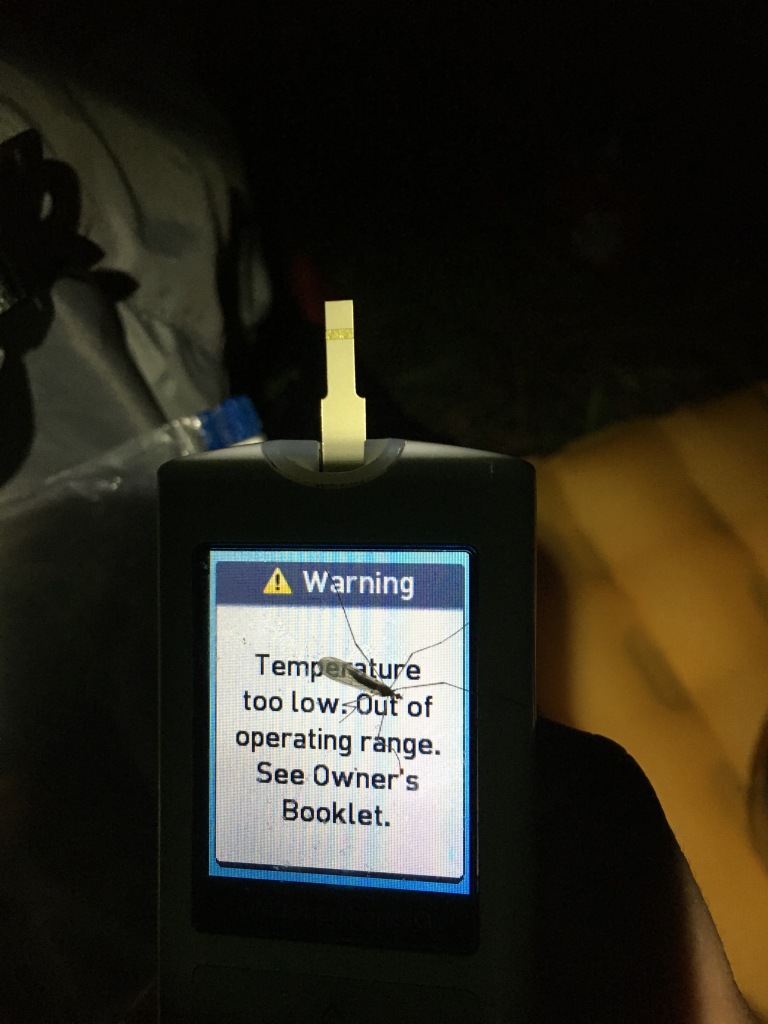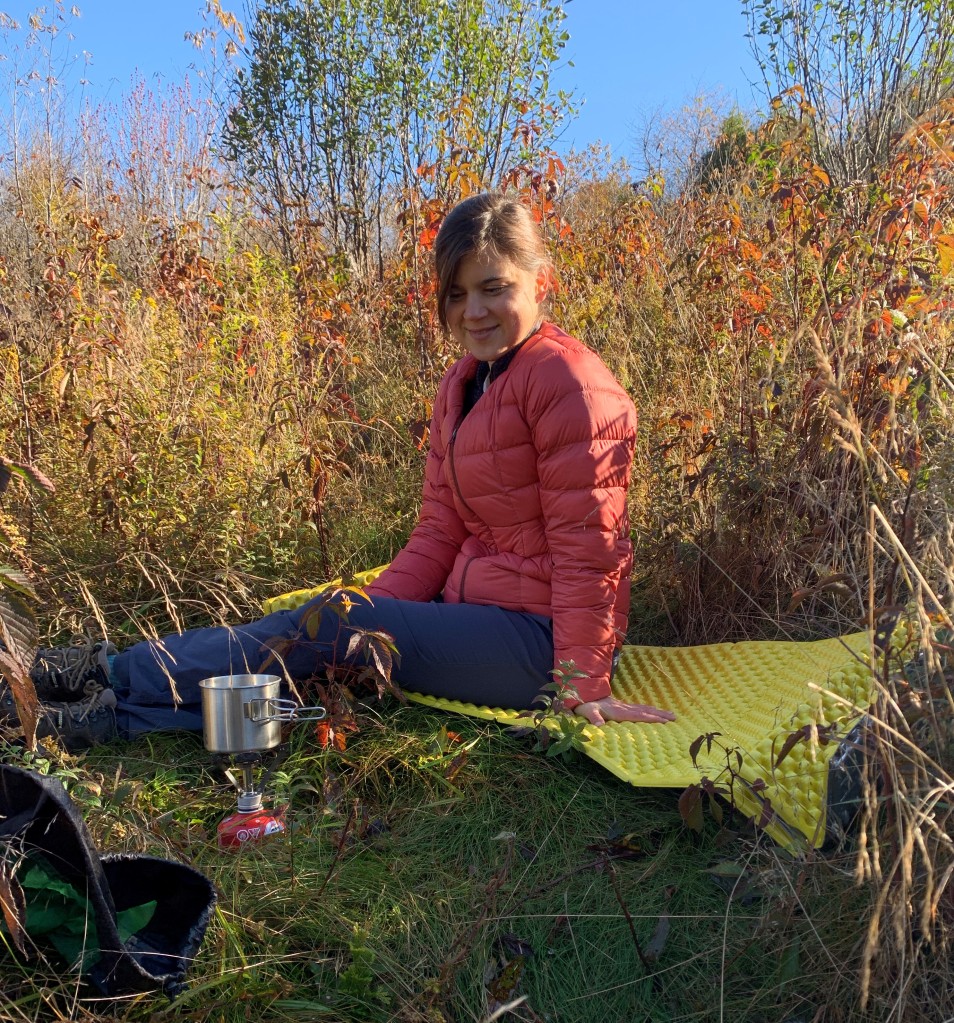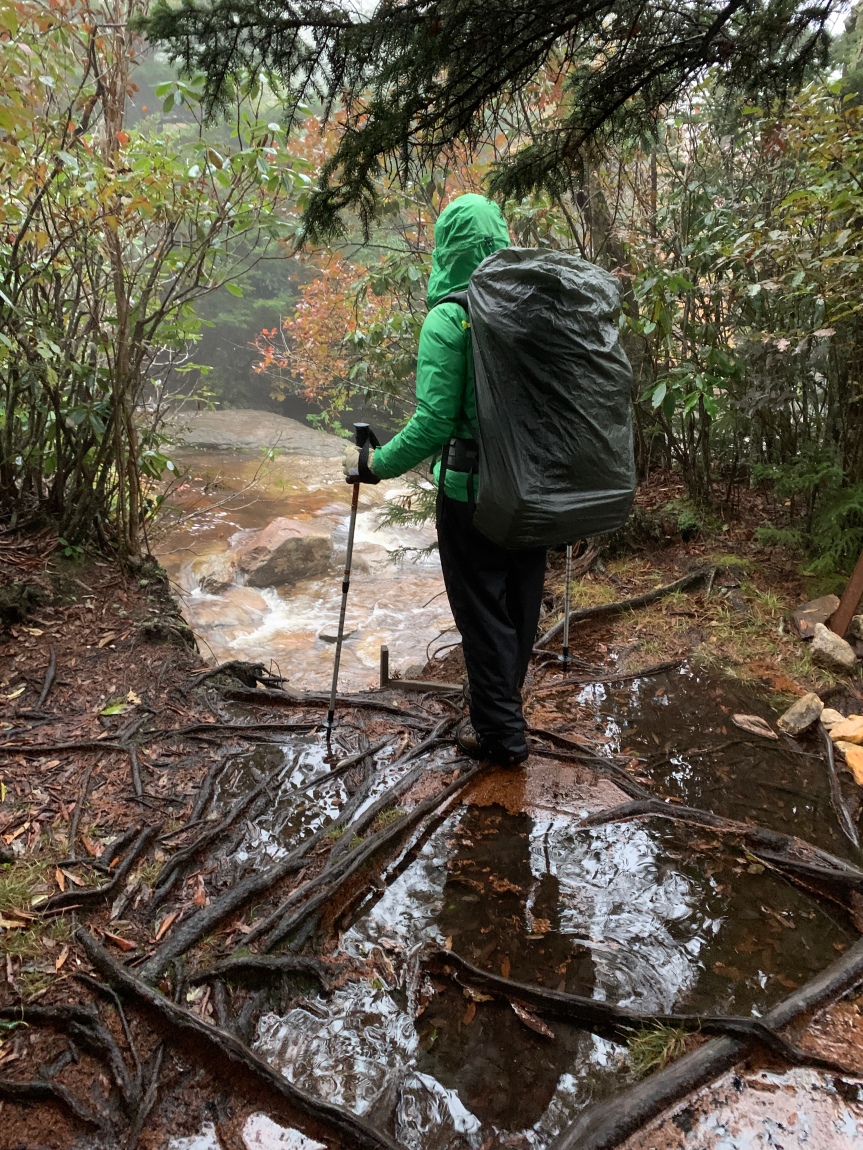Last week I entered a time capsule. It was dark, damp, and cold as we prepared dinner after hiking into a fog so dense that I was shocked when we came to the fork at the base of Sam’s Knob, left to the creek and right to the summit. We had crossed the entire field in front of the mountain without once seeing its mighty figure in front of us. We headed left towards the creekside campsites that I remembered from many years and times before. In fact, I camped beside Flat Laurel Creek during my first ever backpacking trip. That trip, maybe ten years earlier, had started much the same way – with a rainstorm forcing us to pile on every layer we had brought within the first few hours. This time, turning off the parkway and into the parking area for Sam’s Knob, we were the only car save for one. The two guys in the other car were milling about while we worked with raincoats and pack covers to protect ourselves from the intermittent rain showers that threatened to soak us and our gear before we began. They, young, clean, and looking a little lost, wandered over and asked, “Hey, would this be a good time for a hike?” It was chilly and windy, nearly 6 pm, raining lightly, and there was surely standing water in the trails. “Absolutely not,” I said. “This would be a miserable time for a hike,” as my hiking buddy continued to layer and arrange our supplies. “You should come back tomorrow,” I concluded, as we hoisted our packs. “It will be beautiful then.”
That’s what we were banking on anyway. We’d delayed the trip by one day, hard for me once I have my mind set on the woods, but it promised to be a better plan. While it had been raining for the previous day and night, sun and clear skies was forecasted. All we had to do was stay mildly warm and somewhat dry until morning.
I started this blog years ago, inspired by the lessons I learned about diabetes management and myself while backpacking. It diverged, first into kayaking and other outdoor adventures with diabetes, then into topics like acceptance and identity transformation. As I’ve gained experience and had successes problem-solving around unexpected moments with diabetes, like a malfunctioning pod moments before boarding a plane, insulin that overheated in another country, low blood sugars alone, and other occurrences that throw the brakes on every other priority you thought you had, these same moments become less noteworthy. It’s been more likely in recent years for diabetes to surprise me in a philosophical way. So, when I stuck a test strip into my meter to check my blood sugar while simultaneously tending the pan of lentils and rice heating on my little MSR camp stove, I didn’t just see the message, “WARNING – Temperature too cold. Out of operating range. See Owner’s Booklet,” I also saw my younger self; imagined her sitting by the creek ten years ago, overwhelmed by a shock of fear.
There she was, running through a script in her head of everything that could go wrong, of everything that she had to pack in order to survive in the woods. Should the list be so long for one night? Should the consequences be so grave? And then, to be foiled by something you could have never predicted so early in the diabetes game – a meter too cold to function. I felt like hugging her now, as I sat calmly contemplating the crane fly who had been drawn to the screen’s bright glow.

It occurred to me in that moment that sometimes you have to go back to the diabetes basics. It’s not all about the esoteric details of acceptance. Sometimes it’s about snuggling your meter in your sleeping bag as if it were hypothermic until works again. Of course, I gently removed the bug first. This time, I felt confident that my meter would resume functionality because I’d been through similar, though not exact, situations before. I also knew that I had packed an extra meter that was buried deep within the pack, likely in a warmer spot. I had reached for my meter preventively, not waiting until so much time had passed that I had no sense of what my blood sugar was. In short, I was prepared enough to be confident instead of afraid while addressing the issue. I don’t say this in an arrogant way. I fully anticipate moments of fear arising in the future – am planning on it. But zooming out on this small experience was a powerful reminder of how much I’ve learned and grown with this condition.
I was recently talking to my backpacking buddy about the process of learning to do things that I had loved before diagnosis, like camping and kayaking, and new things like backpacking, with diabetes. That process was never just about learning the details of management during different activities; it was equally a process of letting the fear subside. I likened it to what I’ve heard some people say parenting the second child is like. With the first child, you’re on guard for everything. Danger abounds. But by the second child, you’ve gotten through emergencies and been ok enough times to realize that you have more wiggle room than you thought. As I was journaling about this trip though, I realized that it’s also about what those experiences teach you in terms of preparation. I remember being so disturbed when I was first diagnosed that I could no longer run off into the woods and survive “on my own.” That I was dependent not just on two types of insulin, but on meters and batteries and test strips and ketone strips and glucagon kits and glucose tabs and carbs and lancets and alcohol swabs and lancet devices and pen needles and frio packs© and backup of all those things – and that’s just diabetes. All these details and what to do with them and when. It wasn’t really that I was learning how to backpack with diabetes, but more like I was learning how to diabetes through backpacking. Of course, not just through backpacking. I’ve learned the most about diabetes by stepping out my comfort zone. Now, the woods have always been a comfortable zone for me, but the only truly comfortable diabetes zone is near the kitchen with all your supplies and an omniscient level of knowledge about what’s going on in your body. So, traveling, camping, or any other significant change to your routine presents the opportunity for a loss of control and subsequently, inevitable fear. My moments of fear with diabetes have taught me the most about how to handle it, what my margin of error is, and what it takes to be prepared in various situations, known and unknown.
When we reached Flat Laurel Creek, we found it had become a swirling, copper-colored river. I was overcome by its transformation; still beautiful, but ominous in its power. Part of why backpacking has felt like more of an escape even than usual during this pandemic time, is that being outside reminds me that our expectations for constancy are not mirrored by the Earth. Because, as I discussed last post I cannot predict the future, being prepared becomes a process of planning for things to look differently than the ideal. With backpacking, this is a fine line, because weight really does matter and discomfort and danger are two very different things. Sometimes, I find that because my mind is so preoccupied with packing everything I need for diabetes, I forget the importance of all the other gear. I over-emphasize diabetes preparedness as if it were isolated from the rest of me, but as previously mentioned, diabetes is just a bonus on top of all the other processes of survival, like staying warm, fed, and hydrated. So, recently, as I considered whether I could cut some of the weight that I add with diabetes supplies by just being dirtier, aka packing less clothes, I thought about dropping my customary backup pair of socks. I mean, if they get wet I can just dry them out, right? After splashing through several puddles in my decade-old hiking boots that were once waterproof, I was thankful that I had not yet enacted that plan. My feet were wet and I knew they would be cold soon if I didn’t act. For me this feels scary. Once my feet get cold, they just won’t warm back up on their own, which usually leads the rest of me to chill. I didn’t want to become like my meter, too cold to operate. The clouds hung heavy overhead and the wind was picking up, making the little stove work extra hard as I fumbled around in my pack to find the smaller bag that contained my clothes. My hiking companion was off searching for firewood as an exercise in optimism that we gave up on shortly after. Unzipping the smaller bag, I sorted through the layers I had brought – booties, long underwear, and then, just as I began to worry that I had left my spare pair in the car, my teal wool socks appeared. I layered my down booties over them and curled my feet under my body as much as possible. After a (finally) hot dinner I was feeling, if not toasty, warm enough.
Right before curling into the tent, after scraping the last bit of dinner from the pan and tidying our food and toothpaste into the bear canister, the clouds broke and the deep night sky emerged into view. The nearly full moon shone a spotlight on my yellow tent pitched in the middle of a small clearing by the little fork of Flat Laurel. I can’t say I slept warmly, but rested peacefully, nevertheless. The next morning was perfectly cloudless – not even the lightest dappling of shadows. Our solitude at Sam’s Knob quietly evaporated and was replaced by the voices of hikers ringing out as they passed by. After a breakfast of strong instant coffee and sweet instant oatmeal nestled amongst the Mountain Angelica and Ash, we were off.



